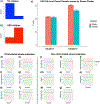Externalizing Behaviors are Associated with Increased Parenting Stress in Caregivers of Young Children with Autism
- PMID: 33837887
- PMCID: PMC9847471
- DOI: 10.1007/s10803-021-04995-w
Externalizing Behaviors are Associated with Increased Parenting Stress in Caregivers of Young Children with Autism
Abstract
Parents of children diagnosed with autism spectrum disorder (ASD) report higher levels of stress than parents of typically developing children. Few studies have examined factors associated with parental stress in early childhood. Even fewer have investigated the simultaneous influence of sociodemographic, clinical, and developmental variables on parental stress. We examined factors associated with stress in parents of young children with ASD. Multiple regression models were used to test for associations between socioeconomic indices, developmental measures, and parental stress. Externalizing behaviors, communication, and socialization skills accounted for variance in parental stress, controlling for ASD diagnosis. Results highlight the importance of interventions aimed at reducing externalizing behaviors in young children as well as addressing stress in caregivers of children with ASD.
Keywords: ASD; Early childhood; Externalizing behaviors; Parental stress.
© 2021. The Author(s), under exclusive licence to Springer Science+Business Media, LLC, part of Springer Nature.
Conflict of interest statement
Declarations
Figures




References
-
- Abidin RR (2012). Parenting stress index, fourth edition (PSI-4). Lutz, Fl: Psychological Assessment Resources.
-
- Achenbach T, & Rescorla L (2000). Child behavior checklist. Retrieved from https://books.google.com/books?hl=en&lr=&id=YxCXh5ZvTksC&oi=fnd&pg=PA372...
-
- American Psychiatric Association. (2013). Diagnostic and statistical manual of mental disorders. (5th ed.). American Psychiatric Association.
-
- Campbell S. (Ed.). (2002). Behavior problems in preschool children: Clinical and developmental issues- PsycNET. (2nd ed.). Guilford Press.
MeSH terms
Grants and funding
LinkOut - more resources
Full Text Sources
Other Literature Sources
Medical

